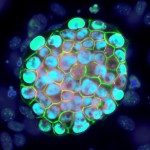Link to Pubmed [PMID] – 10831844
Gene 2000 May;249(1-2):105-13
We have characterized a new mouse gene highly transcribed in the testis, and a derived intronless gene expressed in the embryo. The latter gene is present in Mus musculus domesticus and in Mus musculus castaneus but is absent in Mus spretus. The sequencing of different clones from a testis cDNA library reveals a complex transcriptional regulation for the intron-containing gene. The use of several promoters, alternative splicing and trans-splicing, and of two different polyadenylation sites account for the diversity. The different cDNAs encode proteins with features of basic helix-loop-helix leucine zipper (bHLH-ZIP) DNA-binding factors with homology to a new brain-specific factor. The presence of multiple CK2 and PKC phosphorylation sites suggests that their activity may be regulated by phosphorylation. In man, a pseudogene, apparently derived from the same transcript as in mouse and showing 90% homology in the coding region, is present within an intron of another gene. Interestingly, although the human pseudogene is highly mutated in human, in the mouse it has only four nucleotide changes compared with the cDNA of origin, and is still capable of encoding a protein.

